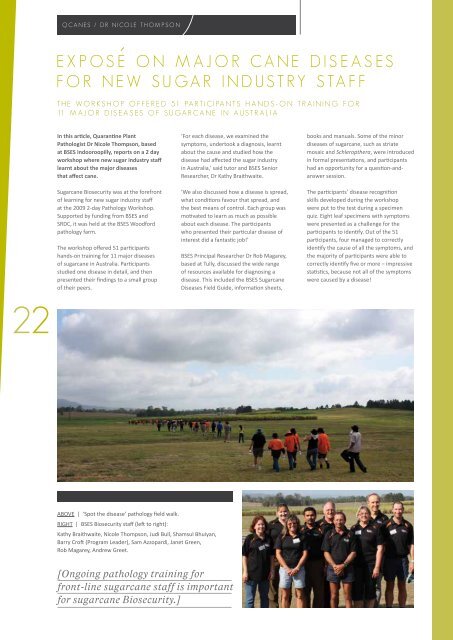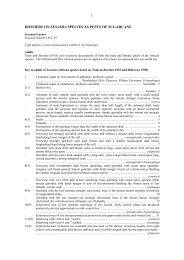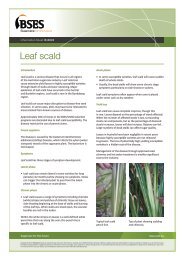Create successful ePaper yourself
Turn your PDF publications into a flip-book with our unique Google optimized e-Paper software.
22<br />
QCANes / Dr NiCOLe ThOMpsON<br />
expOse ON MAjOr CANe DiseAses<br />
fOr NeW suGAr iNDusTry sTAff<br />
The WOrkshOp OffereD 51 pArTiCipANTs hANDs-ON TrAiNiNG fOr<br />
11 MAjOr DiseAses Of suGArCANe iN AusTrALiA<br />
In this article, Quarantine Plant<br />
Pathologist Dr Nicole Thompson, based<br />
at <strong>BSES</strong> Indooroopilly, reports on a 2 day<br />
workshop where new sugar industry staff<br />
learnt about the major diseases<br />
that affect cane.<br />
Sugarcane Biosecurity was at the forefront<br />
of learning for new sugar industry staff<br />
at the 2009 2-day Pathology Workshop.<br />
Supported by funding from <strong>BSES</strong> and<br />
SRDC, it was held at the <strong>BSES</strong> Woodford<br />
pathology farm.<br />
The workshop offered 51 participants<br />
hands-on training for 11 major diseases<br />
of sugarcane in Australia. Participants<br />
studied one disease in detail, and then<br />
presented their findings to a small group<br />
of their peers.<br />
ABOVE | ‘Spot the disease’ pathology field walk.<br />
RIGHT | <strong>BSES</strong> Biosecurity staff (left to right):<br />
Kathy Braithwaite, Nicole Thompson, Judi Bull, Shamsul Bhuiyan,<br />
Barry Croft (Program leader), Sam Azzopardi, Janet Green,<br />
Rob Magarey, Andrew Greet.<br />
‘for each disease, we examined the<br />
symptoms, undertook a diagnosis, learnt<br />
about the cause and studied how the<br />
disease had affected the sugar industry<br />
in Australia,’ said tutor and <strong>BSES</strong> Senior<br />
Researcher, Dr Kathy Braithwaite.<br />
‘We also discussed how a disease is spread,<br />
what conditions favour that spread, and<br />
the best means of control. Each group was<br />
motivated to learn as much as possible<br />
about each disease. The participants<br />
who presented their particular disease of<br />
interest did a fantastic job!’<br />
<strong>BSES</strong> Principal Researcher Dr Rob Magarey,<br />
based at Tully, discussed the wide range<br />
of resources available for diagnosing a<br />
disease. This included the <strong>BSES</strong> Sugarcane<br />
Diseases field Guide, information sheets,<br />
[Ongoing pathology training for<br />
front-line sugarcane staff is important<br />
for sugarcane Biosecurity.]<br />
books and manuals. Some of the minor<br />
diseases of sugarcane, such as striate<br />
mosaic and Schleropthera, were introduced<br />
in formal presentations, and participants<br />
had an opportunity for a question-andanswer<br />
session.<br />
The participants’ disease recognition<br />
skills developed during the workshop<br />
were put to the test during a specimen<br />
quiz. Eight leaf specimens with symptoms<br />
were presented as a challenge for the<br />
participants to identify. Out of the 51<br />
participants, four managed to correctly<br />
identify the cause of all the symptoms, and<br />
the majority of participants were able to<br />
correctly identify five or more – impressive<br />
statistics, because not all of the symptoms<br />
were caused by a disease!




